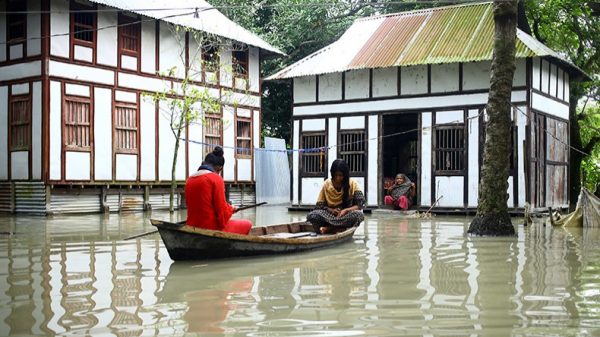Fresh flood fear slows rehab plan

Shawdesh desk:
Hundreds of flood victims continue to live under the open sky, especially in northern Bangladesh as the likelihood of further flooding left the government undecided as to whether or not to begin its rehabilitation efforts.
As the worst flood in two decades badly impacted livelihoods of the victims, it also forced them to start borrowing from the local loan sharks to meet their immediate needs such as food and shelter.
The crisis over delayed rehabilitation is likely to worsen further over the next couple of days as three central rivers were flowing above their danger marks until Friday.
Consequently, thousands of flood victims in central Bangladesh, who are expected to leave shelters, are returning home at a slower pace.
‘We are a bit slow in rehabilitation because of the likelihood of further flooding,’ disaster management and relief secretary Md Mohsin told New Age.
‘We are observing the situation. By definition rehabilitation comes after a disaster and parts of Bangladesh are still under water,’ he said.
The upstream rivers of north fell below their flood levels about a week ago allowing over 50,000 people to return to their houmes after about a month and a half of their stay on embankments.
For over a month the northern rivers flowed with extreme force sweeping away people, livestock, houses and damaging vast crop fields.
After the floodwater receded, many returned home to see their houses missing while others found them buried in tons of mud.
Asma Khatun, a resident of Char Bhelakopa in Kurigram Sadar, has been living literally on sand ever since she returned home five days ago with her two children showing symptoms of pneumonia.
Though relatives helped her with food she could not renovate her house with her husband gone to Dhaka to pull rickshaw.
‘I heard he has contracted coronavirus and has been ill for the last 13 days in Dhaka,’ said Asma, who did not receive a penny from her husband so far.
In Char Haguriya Hashim of Pirgachha in Rangpur, Rabeya Bewa borrowed 120kg of rice from an affluent neighbour on the condition of returning three times in six months.
Gushing water swept away Rabeya’s house and husband at the beginning of the flood and she has three children to feed.
‘I know I will soon run out of my rice stock. I badly need work before it does,’ said Rabeya.
Rabeya used to be a daily wage labourer before the flood. There are hundreds of others like her who do not have any work immediately after the flood but are in need of cash to restart their lives.
The flood also striped many farmers of their crops, fishes and livestock as well.
Fayez Uddin, 70, a farmer of Chollishal Char of Gangachara in Rangpur, loaned Tk 5,000 at Tk 700 weekly instalment from a local loan shark.
He took out the loan on the condition of keep paying the weekly instalment as long as he cannot payback the total loaned amount.
‘I don’t have a choice here. I need money to feed my family and rebuild my home,’ said Fayez.
The disaster management and relief ministry could not yet complete estimating the number of people who require immediate government help.
Rangpur divisional commissioner’s office estimated that over 23,000 people lost their houses in the division alone.
The disaster management and relief ministry’s latest report showed that it distributed only 100 bundles of corrugated sheets and Tk 3 lakh to help people rebuild their houses.
The relief that the government distributed so far was also far less than the demand as the worst flood in decades affected over 5.5 million, nearly a lakh of them driven out of their homes.
Besides giving Tk 6 crore, the government distributed 12,701 tonnes of rice and 1.41 lakh packets of dry foods among the affected people during the flood that passed its 49th day on Friday, the longest since 1998.
A Flood Forecasting and Warning Centre bulletin said that the Jamuna, Teesta, Ghaghat and Karatoa swelled in the 24 hours until 9:00am on Friday.
Water Development Board executive engineer Mehedi Hasan said that the northern rivers were in rising trend and further flooding might occur depending on rain in the upstream.
The FFWC bulletin showed that the three rivers in central Bangladesh — Gur, Dhaleswari and Tongi Khal — receded in the 24 hours until Friday morning rather slowly.
The Gur was flowing 12cm above its danger mark while the Dhaleshwari was above 6cm and Tongi Khal 1cm above their danger marks.
Flood-affected people in central Bangladesh, including Dhaka, experienced a very slow fall in floodwater level as 36,132 people were still at 1,133 flood shelters in central districts.
Health emergency control room said that 216 people were killed due to causes related to the deluge since June 27.
Bangladesh Meteorological Department said that 1-2 feet above the normal tide might inundate the low-lying areas of Bangladesh’s 12 coastal districts and their offshore islands under the influence of a low over northwest bay and strong monsoon.
The BMD asked all fishing boats and trawlers to move with caution while advising the country’s four maritime ports to hoist signal No 3 until further notice.
India Metrological Department predicted fairly widespread to widespread rainfall in upstream such as Arunachal Pradesh, Assam and Meghalaya, West Bengal and Sikkim, Gangetic West Bengal and Bihar through Tuesday.





























Leave a Reply